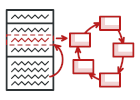
State en TypeScript
State es un patrón de diseño de comportamiento que permite a un objeto cambiar de comportamiento cuando cambia su estado interno.
El patrón extrae comportamientos relacionados con el estado, los coloca dentro de clases de estado separadas y fuerza al objeto original a delegar el trabajo de una instancia de esas clases, en lugar de actuar por su cuenta.
Complejidad:
Popularidad:
Ejemplos de uso: El patrón State se utiliza habitualmente en TypeScript para convertir las enormes máquinas de estados basadas en switch, en objetos.
Identificación: El patrón State se puede reconocer por métodos que cambian su comportamiento dependiendo del estado del objeto, controlado externamente.
Ejemplo conceptual
Este ejemplo ilustra la estructura del patrón de diseño State y se centra en las siguientes preguntas:
- ¿De qué clases se compone?
- ¿Qué papeles juegan esas clases?
- ¿De qué forma se relacionan los elementos del patrón?
index.ts: Ejemplo conceptual
/**
* The Context defines the interface of interest to clients. It also maintains a
* reference to an instance of a State subclass, which represents the current
* state of the Context.
*/
class Context {
/**
* @type {State} A reference to the current state of the Context.
*/
private state: State;
constructor(state: State) {
this.transitionTo(state);
}
/**
* The Context allows changing the State object at runtime.
*/
public transitionTo(state: State): void {
console.log(`Context: Transition to ${(<any>state).constructor.name}.`);
this.state = state;
this.state.setContext(this);
}
/**
* The Context delegates part of its behavior to the current State object.
*/
public request1(): void {
this.state.handle1();
}
public request2(): void {
this.state.handle2();
}
}
/**
* The base State class declares methods that all Concrete State should
* implement and also provides a backreference to the Context object, associated
* with the State. This backreference can be used by States to transition the
* Context to another State.
*/
abstract class State {
protected context: Context;
public setContext(context: Context) {
this.context = context;
}
public abstract handle1(): void;
public abstract handle2(): void;
}
/**
* Concrete States implement various behaviors, associated with a state of the
* Context.
*/
class ConcreteStateA extends State {
public handle1(): void {
console.log('ConcreteStateA handles request1.');
console.log('ConcreteStateA wants to change the state of the context.');
this.context.transitionTo(new ConcreteStateB());
}
public handle2(): void {
console.log('ConcreteStateA handles request2.');
}
}
class ConcreteStateB extends State {
public handle1(): void {
console.log('ConcreteStateB handles request1.');
}
public handle2(): void {
console.log('ConcreteStateB handles request2.');
console.log('ConcreteStateB wants to change the state of the context.');
this.context.transitionTo(new ConcreteStateA());
}
}
/**
* The client code.
*/
const context = new Context(new ConcreteStateA());
context.request1();
context.request2();
Output.txt: Resultado de la ejecución
Context: Transition to ConcreteStateA.
ConcreteStateA handles request1.
ConcreteStateA wants to change the state of the context.
Context: Transition to ConcreteStateB.
ConcreteStateB handles request2.
ConcreteStateB wants to change the state of the context.
Context: Transition to ConcreteStateA.
 LA OFERTA DE INVIERNO ESTÁ AQUÍ!
LA OFERTA DE INVIERNO ESTÁ AQUÍ!
